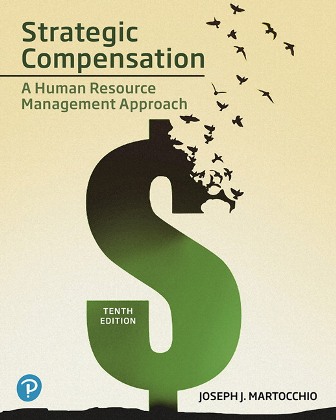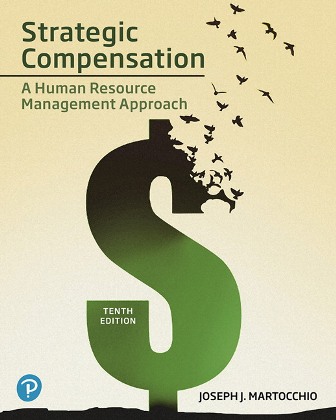Test Bank for Strategic Compensation, 10th Edition, Joseph J. Martocchio

Product details:
- ISBN-10 : 0135192145
- ISBN-13 : 978-0135192146
- Author:
For graduate and undergraduate courses in compensation, staffing, and human resources. The art and science of compensation practice. Strategic Compensation: A Human Resource Management Approach illustrates the art and science of compensation practice and its role in promoting a company’s competitive advantage. The seventh edition was thoroughly revised, and now includes current statistics and a new chapter offering the latest information to compensation professionals.
Table contents:
- I Setting the Stage for Strategic Compensation
- 1 Strategic Compensation A Component of Human Resource Systems
- Learning Objectives
- Defining Strategic Compensation
- What Is Compensation?
- What Is Strategic Compensation?
- Compensation as a Strategic Business Partner
- Strategic Compensation Decisions
- Competitive Business Strategy Choices
- Lowest-Cost Strategy
- Differentiation Strategy
- Compensation Decisions that Support the Firm’s Strategy
- Employee Roles Associated with Competitive Strategies
- Building Blocks and Structure of Strategic Compensation Systems
- Building Blocks: Core Compensation and Employee Benefits
- Core Compensation
- Employee Benefits
- Fundamental Compensation System Design Elements
- Internal Consistency
- Market Competitiveness
- Recognizing Employee Contributions
- Alternative Pay Structure Configurations
- Fitting the Compensation Function in an Organization’s Structure
- How HR Professionals Fit into the Corporate Hierarchy
- The Compensation Profession
- How the Compensation Function Fits into HR Departments
- Compensation, Recruitment, and Selection
- Compensation and Performance Appraisal
- Compensation and Training
- Compensation and Career Development
- Compensation and Labor–Management Relations
- Compensation and Employment Termination
- Compensation and Legislation
- Stakeholders of the Compensation System
- Employees
- Line Managers
- Executives
- Unions
- U.S. Government
- Developing Skills for Your Career
- Communication
- Critical Thinking
- Collaboration
- Knowledge Application and Analysis
- Business Ethics and Social Responsibility
- Information Technology Application and Computing Skills
- Data Literacy
- Preparing for Exams/Quizzes
- Chapter Summary by Learning Objectives
- Key Terms
- Discussion Questions
- Preparing for My Career
- Compensation in Action
- Action checklist for line managers and HR—aligning compensation with strategy
- HR takes the lead
- Line managers take the lead
- Working Together: Team Exercise
- Questions:
- Endnotes
- 2 Contextual Influences on Compensation Practice
- Learning Objectives
- Interindustry Wage Differentials
- Pay Differentials Based on Occupational Characteristics
- Geographic Pay Differentials
- Labor Unions
- Employment Laws Pertinent to Compensation Practice
- Income Continuity, Safety, and Work Hours
- Fair Labor Standards Act of 1938
- Minimum Wage
- Overtime Provisions
- Child Labor Provisions
- Pay Discrimination
- Equal Pay Act of 1963
- Civil Rights Act of 1964
- Bennett Amendment
- Age Discrimination in Employment Act of 1967 (As Amended in 1978, 1986, and 1990)
- Civil Rights Act of 1991
- Accommodating Disabilities and Family Needs
- Pregnancy Discrimination Act of 1978
- Americans with Disabilities Act of 1990
- Family and Medical Leave Act of 1993
- Prevailing Wage Laws
- Davis–Bacon Act of 1931
- Walsh–Healey Public Contracts Act of 1936
- Preparing for Exams/Quizzes
- Chapter Summary by Learning Objectives
- Key Terms
- Discussion Questions
- II Bases for Pay
- 3 Traditional Bases for Pay Seniority and Merit
- Learning Objectives
- Seniority and Longevity Pay
- Historical Overview
- Who Participates?
- Effectiveness of Seniority Pay Systems
- Design of Seniority Pay and Longevity Pay Plans
- Advantages of Seniority Pay
- Fitting Seniority Pay with Competitive Strategies
- Merit Pay
- Who Participates?
- Exploring the Elements of Merit Pay
- Performance Appraisal
- Types of Performance Appraisal Plans
- Trait Systems
- Comparison Systems
- Behavioral Systems
- Goal-Oriented Systems
- Exploring the Performance Appraisal Process
- Four Activities to Promote Nondiscriminatory Performance Appraisal Practices
- Sources of Performance Appraisal Information
- Errors in the Performance Appraisal Process
- Bias Errors
- Contrast Errors
- Errors of Central Tendency
- Errors of Leniency or Strictness
- Are Traditional Performance Appraisal Methods Becoming Irrelevant?
- Strengthening the Pay-for-Performance Link
- Link Performance Appraisals to Business Goals
- Analyze Jobs
- Communicate
- Establish Effective Appraisals
- Empower Employees
- Differentiate Among Performers
- Possible Limitations of Merit Pay Programs
- Failure to Differentiate among Performers
- Poor Performance Measures
- Supervisors’ Biased Ratings of Employee Job Performance
- Lack of Open Communication between Management and Employees
- Undesirable Social Structures
- Mounting Costs
- Factors Other than Merit
- Undesirable Competition
- Little Motivational Value
- Preparing for Exams/Quizzes
- Chapter Summary by Learning Objectives
- Key Terms
- Discussion Questions
- 4 Incentive Pay
- Learning Objectives
- Exploring Incentive Pay
- Contrasting Incentive Pay with Traditional Pay
- Individual Incentives
- Defining Individual Incentives
- Types of Individual Incentive Plans
- Piecework Plans
- Management Incentive Plans
- Behavioral Encouragement Plans
- Referral Plans
- Spot Bonuses
- Signing Bonuses
- Advantages of Individual Incentive Pay Programs
- Disadvantages of Individual Incentive Pay Programs
- Group Incentives
- Defining Group Incentives
- Types of Group Incentive Plans
- Team-Based or Small-Group Incentive Plans
- Gainsharing Plans
- The Scanlon Plan
- The Rucker Plan
- Advantages of Group Incentives
- Disadvantages of Group Incentives
- Company-Wide Incentives
- Defining Company-wide Incentives
- Types of Company-wide Incentive Plans
- Profit Sharing Plans
- Calculating Profit Sharing Awards
- Advantages of Profit Sharing Plans
- Disadvantages of Profit Sharing Plans
- Employee Stock Option Plans
- Designing Incentive Pay Programs
- Group versus Individual Incentives
- Level of Risk
- Complementing or Replacing Base Pay
- Performance Criteria
- Time Horizon: Short Term versus Long Term
- Preparing for Exams/Quizzes
- Chapter Summary by Learning Objectives
- Key Terms
- Discussion Questions
- 5 Person-Focused Pay
- Learning Objectives
- Defining Person-Focused Pay: Pay-For-Knowledge, Skill-Based Pay, and Competency-Based Pay
- Knowledge-Based Pay and Skill-Based Pay
- Competency-Based Pay and the Competency Model Clearinghouse
- Foundational Competencies
- Industry-Related Competencies
- Occupation-Related Competencies
- Usage of Person-Focused Pay Programs
- Reasons to Adopt Person-Focused Pay Programs
- Technological Innovation
- Increased Global Competition
- Varieties of Person-Focused Pay Programs
- Contrasting Person-Focused Pay with Job-Based Pay
- Advantages and Disadvantages of Person-Focused Pay Programs
- Advantages
- Disadvantages
- Preparing for Exams/Quizzes
- Chapter Summary by Learning Objectives
- Key Terms
- Discussion Questions
- Endnotes
- III Designing Compensation Systems
- 6 Building Internally Consistent Compensation Systems
- Learning Objectives
- Internal Consistency
- Job Analysis
- Steps in the Job Analysis Process
- Determine a Job Analysis Program
- Select and Train Analysts
- Direct Job Analyst Orientation
- Conduct The Study: Data Collection Methods and Sources of Data
- Summarize the Results: Writing Job Descriptions
- Legal Considerations for Job Analysis
- Job Analysis Techniques
- Occupational Information Network (O*NET)
- Experience Requirements
- Occupational Requirements
- Occupation-Specific Information Requirements
- Workforce Characteristics
- Worker Characteristics
- Worker Requirements
- Using O*NET
- Job Evaluation
- Compensable Factors
- The Job Evaluation Process
- Determining Single Versus Multiple Job Evaluation Techniques
- Choosing The Job Evaluation Committee
- Training Employees to Conduct Job Evaluations
- Documenting The Job Evaluation Plan
- Communicating with Employees
- Setting up the Appeals Process
- Job Evaluation Techniques
- The Point Method
- Step 1: Select Benchmark Jobs
- Step 2: Choose Compensable Factors Based on Benchmark Jobs
- Step 3: Define Factor Degrees
- Step 4: Determine the Weight of Each Factor
- Step 5: Determine Point Values for Each Compensable Factor
- Step 6: Verify Factor Degrees and Point Values
- Step 7: Evaluate all Jobs
- Balancing Internal and Market Considerations Using the Point Method
- Alternative Job-Content Evaluation Approaches
- Simple Ranking Plans
- Paired Comparison and Alternation Ranking
- Classification Plans
- Alternatives to Job Evaluation
- Internally Consistent Compensation Systems and Competitive Strategy
- Preparing for Exams/Quizzes
- Chapter Summary by Learning Objectives
- Key Terms
- Discussion Questions
- 7 Building Market-Competitive Compensation Systems
- Learning Objectives
- Market-Competitive Pay Systems: The Basic Building Blocks
- Compensation Surveys
- Preliminary Considerations
- What Companies Hope to Gain from Compensation Surveys
- Custom Development Versus use of an Existing Compensation Survey
- Using Published Compensation Survey Data
- Survey Focus: Core Compensation or Employee Benefits
- Sources of Published Compensation Surveys
- Employment Cost Trends
- National Compensation Data
- Wages by Area and Occupation
- Earnings by Demographics
- Earnings by Industry
- County Wages (Quarterly Census of Employment and Wages)
- Employee Benefits
- Compensation Surveys: Strategic Considerations
- Defining the Relevant Labor Market
- Choosing Benchmark Jobs
- Compensation Survey Data
- Using the Appropriate Statistics to Summarize Survey Data
- Updating the Survey Data
- Integrating Internal Job Structures with External Market Pay Rates
- Compensation Policies and Strategic Mandates
- Pay Level Policies
- Pay Mix Policies
- Preparing for Exams/Quizzes
- Chapter Summary by Learning Objectives
- Key Terms
- Discussion Questions
- 8 Building Pay Structures That Recognize Employee Contributions
- Learning Objectives
- Constructing a Pay Structure
- Step 1: Deciding on the Number of Pay Structures
- Exempt and Nonexempt Pay Structures
- Pay Structures Based on Job Family
- Pay Structures Based on Geography
- Step 2: Determining a Market Pay Line
- Step 3: Defining Pay Grades
- Step 4: Calculating Pay Ranges for Each Pay Grade
- Pay Compression
- Green Circle Pay Rates
- Red Circle Pay Rates
- Step 5: Evaluating the Results
- Designing Merit Pay Systems
- Merit Increase Amounts
- Timing
- Recurring versus Nonrecurring Merit Pay Increases
- Present Level of Base Pay
- Rewarding Performance: The Merit Pay Grid
- Employees’ Performance Ratings
- Employees’ Positions Within the Pay Range
- Merit Pay Increase Budgets
- Designing Sales Incentive Compensation Plans
- Alternative Sales Compensation Plans
- Salary-Only Plans
- Salary-Plus-Bonus Plans
- Salary-Plus-Commission Plans
- Commission-Plus-Draw Plans
- Commission-Only Plans
- Sales Compensation Plans and Competitive Strategy
- Determining Fixed Pay and the Compensation Mix
- Influence of the Salesperson on the Buying Decision
- Competitive Pay Standards Within the Industry
- Amount of Nonsales Activities Required
- Designing Person-Focused Programs
- Establishing Skill Blocks
- Transition Matters
- Skills Assessment
- Aligning Pay with the Knowledge Structure
- Access to Training
- Training and Certification
- In-House or Outsourcing Training
- Expertise
- Timeliness
- Size of the Employee Population to be Trained
- Sensitivity or proprietary nature of the subject matter
- Certification and recertification
- Pay Structure Variations
- Broadbanding
- The Broadbanding Concept and its Advantages
- Limitations of Broadbanding
- Two-Tier Pay Structures
- The Two-Tier Pay System Concept and its Advantages
- Limitations of Two-Tier Pay Structures
- Preparing for Exams/Quizzes
- Chapter Summary By Learning Objectives
- Key Terms
- Discussion Questions
- IV Employee Benefits
- 9 Discretionary Benefits
- Learning Objectives
- Origins of Discretionary Benefits
- Categories of Discretionary Benefits
- Protection Programs
- Disability Insurance
- Life Insurance
- Retirement Programs
- Paid Time Off
- Services
- Employee Assistance Programs
- Family Assistance Programs
- Educational Benefits
- Transportation Services
- Outplacement Assistance
- Wellness Programs
- Financial Education
- Student Loan Repayment Assistance
- Pet Insurance
- Legislation Pertinent to Discretionary Benefits
- Internal Revenue Code
- Employee Retirement Income Security Act of 1974 (ERISA)
- Pension Protection Act of 2006
- Defined Benefit Plans
- Defined Contribution Plans
- Designing and Planning the Benefits Program
- Determining Who Receives Coverage
- Financing
- Employee Choice
- Cost Containment
- Communication
- The Benefits and Costs of Discretionary Benefits
- Preparing for Exams/Quizzes
- Chapter Summary by Learning Objectives
- Key Terms
- Discussion Questions
- 10 Legally Required Benefits
- Learning Objectives
- Origins of Legally Required Benefits
- Categories of Legally Required Benefits
- Social Security Programs
- Unemployment Insurance
- Old age, Survivor, and Disability Insurance
- Old age Benefits
- Survivor Benefits
- Disability Benefits
- Medicare
- Medicare Part a Coverage
- Medicare Part B Coverage
- Medigap Insurance
- Medicare Part C Coverage—Medicare Advantage
- Medicare Prescription Drug Benefits
- Financing Oasdi and Medicare Programs
- Oasdi Programs
- Medicare Programs
- Workers’ Compensation
- Workers’ Compensation Objectives and Obligations to the Public
- How Workers’ Compensation Compares to Social Security Benefits
- Recent Trends in Workers’ Compensation
- Financing Workers’ Compensation Programs
- Family and Medical Leave
- State and Local Paid Leave Laws
- Health Insurance
- Health Insurance Program Design Alternatives
- Fee-For-Service Plans
- Managed-care Approach
- Health Maintenance Organizations
- Preferred Provider Organizations
- Exclusive Provider Organizations
- Point-of-Service Plans
- Features of Health Care Plans
- Deductible
- Coinsurance
- Out-of-Pocket Maximum
- Preexisting Condition Clauses
- Lifetime and Yearly Limits
- Specialized Insurance Benefits
- Prescription Drug Plans
- Mental Health and Substance Abuse
- Consumer-Driven Health Care
- Additional Health Care Legislation
- Consolidated Omnibus Budget Reconciliation Act of 1985 (COBRA)
- Health Insurance Portability and Accountability Act of 1996 (HIPAA)
- The Benefits and Costs of Legally Required Benefits
- Preparing for Exams/Quizzes
- Chapter Summary by Learning Objectives
- Key Terms
People also search:
strategic compensation 10th edition
strategic compensation 10th edition pdf free
strategic compensation 10th edition pdf
strategic compensation a human resource management approach 10th edition
what is strategic compensation
what is compensation strategy
strategic compensation book





